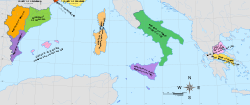Scotland and France
Norman or French culture first gained a foothold in Scotland during the Davidian Revolution, when King David I introduced Continental-style reforms throughout all aspects of Scottish life: social, religious, economic and administrative. He also invited immigrant French and Anglo-French peoples to Scotland. This effectively created a Franco-Scottish aristocracy, with ties to the French aristocracy as well as many to the Franco-English aristocracy. From the Wars of Scottish Independence, as common enemies of England and its ruling House of Plantagenet, Scotland and France started to enjoy a close diplomatic relationship, the Auld Alliance, from 1295 to 1560. From the Late Middle Ages and into the Early Modern Period Scotland and its burghs also benefited from close economic and trading links with France in addition to its links to the Low Countries, Scandinavia and the Baltic.
The prospect of dynastic union came in the 15th and 16th centuries, when Margaret, eldest daughter of James I of Scotland, married the future Louis XI of France. James V of Scotland married two French brides in succession. His infant daughter, Mary I, succeeded him on his death in 1542. For many years thereafter the country was ruled under a regency led by her French mother, Mary of Guise, who succeeded in marrying her daughter to the future Francis II of France. The young couple were king and queen of France and Scotland from 1559 until Francis died in 1560. Mary returned to a Scotland heaving with political revolt and religious revolution, which made a continuation of the alliance impossible.
Cordial economic and cultural relations did continue however, although throughout the 17th century, the Scottish establishment became increasingly Presbyterian, often belligerent to Catholicism, a facet which was somewhat at odds with Louis XIV's aggressively Catholic foreign and domestic policy. The relationship was further weakened by the Union of the Crowns in 1603, which meant from then on that although still independent, executive power in the Scottish government, the Crown, was shared with the Kingdom of England and Scottish foreign policy came into line more with that of England than with France. France would later support the Catholic Stuart pretenders.


